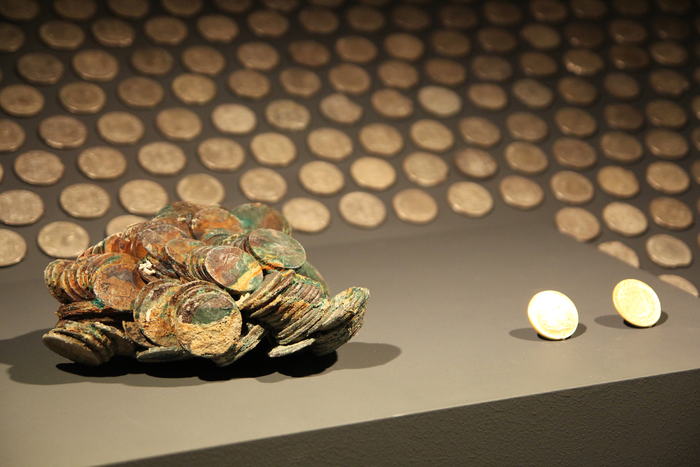JOSE ANTONIO SUAREZ,. The largest underwater treasure in history, composed of 500,000 gold and silver coins that Odissey found in the Gulf of Cádiz, originally belonged to Diego de Alvear Ponce de León, descendant of the most famous winemakers of Montilla and the Dukes of Arcos, lords of Marchena.
Underwater archaeologists from the American company Odyssey discovered in 2007 the remains of the frigate in the Gulf of Cádiz, taking with them the 590,000 silver coins that once formed the family fortune to the USA. The Spanish state litigated, won, and Odyssey returned the fortune of Diego de Alvear.
The gold from the ancient Spanish galleons sunk in the Gulf of Cádiz belongs, by international law and various treaties, to Spain. This is because sunken state vessels, including warships and other state-owned ships like galleons, remain the property of the state that owned them, unless that state explicitly relinquishes its rights.

On October 5, 1804, off the coast of Cape Santa Maria, Algarve, the frigate ‘Virgen de las Mercedes’ was cannoned and sunk by the English. This ship is now famous thanks to the treasure-hunting company, Odyssey. On board was the navy general born in Montilla, Diego de Alvear Ponce de León, along with his family.
The vast majority of the shipwrecks from the galleons of the Indies lie at the bottom of the Bay of Cádiz. There remain thousands of tons of gold, silver, and precious stones from America. And those who know this best are the pirates of the 21st century, the treasure hunters. Periodically, security forces conduct operations, detaining rogue divers and implicated businessmen due to the neglect of underwater treasures by our authorities.»
In the attack, almost his entire family perished, except for the general and his eldest son. He also lost all the wealth accumulated over 30 years as a military officer in Rio de la Plata. Two months later, Spain declared war on Great Britain, which agreed to pay compensation to the Alvear family of 12,000 pounds. However, they seized the rest of the fleet, three ships, and imprisoned the survivors.
In the shipwreck of the frigate, 249 sailors died; the 51 survivors were taken prisoner and transferred to the United Kingdom, among them the Navy Captain Diego de Alvear y Ponce de León.
Diego de Alvear y Ponce de León (Montilla, 1749) was the grandson of the founder of the “Alvear” wineries in Montilla (1729) and of María Escolástica Fernández Ponce de León, a descendant of the Dukes of Arcos and lord of Marchena, and he had been distinguished for his military services to the King.
His grandmother was Inés Ponce de León Enriquez de Ribera, the niece of the Duke of Arcos, Joaquín Ponce de León, and the daughter of his brother Gabriel, Duke of Aveiro.
After being educated by the Jesuits in Montilla, Diego de Alvear joined the navy and traveled to Uruguay where he became a general and married María Josefa Balbastro in 1781. His daughter, Sabina de Alvear, wrote the history of her father and began marketing the wines from the winery in Europe. Her children started a lineage of politicians in Argentina, such as Marcelo Torcuato de Alvear, who was the president of the Republic of Argentina from 1922 to 1928.
In Cádiz, Diego de Alvear fought against the French and, after the War of Independence, he traveled through Europe. In 1817, he returned to Montilla and became involved in the family’s wine business. During the liberal triennium, he confronted the enemies of the liberal government. He passed away in Madrid where he had traveled for the wedding of Fernando VII and María Cristina.
«The Alvear family settled in Córdoba when Juan Bautista García de Alvear y Garnica, born in Nájera (La Rioja) in 1657, was appointed as Administrator of the Royal Revenues in Córdoba. His son, Diego de Alvear y Escalera, moved to Montilla where, in 1729, he built the Alvear winery. With the assistance of his son Santiago, he expanded and boosted the winery, sending the first shipments of wine to England by the end of that century.
In three archaeological campaigns carried out in 2015, 2016, and 2017, the National Museum of Underwater Archaeology, in collaboration with the Spanish Institute of Oceanography and the Navy, conducted a series of deep dives (more than 1100 meters) to retrieve the pieces most susceptible to looting and to assess the state of the shipwreck. It was confirmed that Odyssey had collected coins by sweeping the seabed, severely damaging the remains of the ship.»
There are several reasons why the treasures are not always recovered:
Technical Challenges: The depth and conditions at which some of these galleons lie make them technically challenging and expensive to recover.
Archaeological Importance: These shipwrecks are considered underwater cultural heritage. Simply retrieving the treasures could disturb the site and destroy valuable historical and archaeological information. Proper archaeological procedures must be followed, which can be time-consuming and expensive.
Legal Disputes: While the gold may belong to Spain, the waters in which they are found might be subject to territorial disputes. Moreover, there have been numerous legal battles between Spain and treasure hunting companies, like the case with Odyssey Marine Exploration when they found the treasure from the shipwreck «Nuestra Señora de las Mercedes.»
Economic Costs: The cost of mounting a salvage operation, especially one that adheres to archaeological standards, can be prohibitive. The value of the recovered treasure might not always cover the costs of recovery.
Preservation of the Sites: Some argue that the shipwrecks should be left undisturbed as underwater memorials to the sailors who perished.
Risk of Looting: Once a salvage operation begins, it can attract attention and potentially lead to unauthorized looters trying to lay claim to parts of the treasure.
